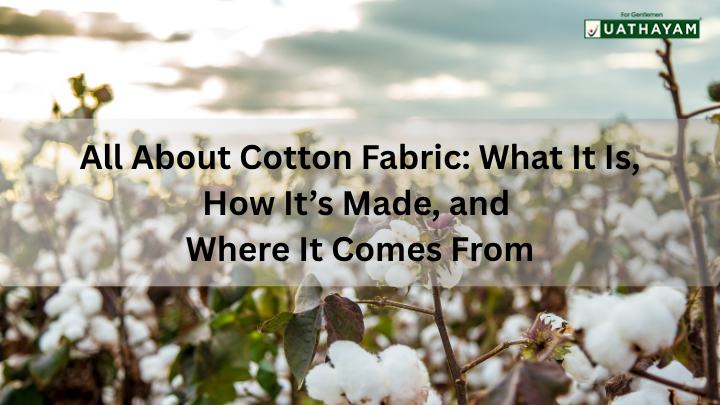All About Cotton Fabric: What It Is, How It’s Made, and Where It Comes From
Cotton fabric is everywhere, from your favourite t-shirt to those cozy bedsheets and the crisp shirt you wear to work. It’s soft, breathable, and feels like a hug from nature. But what exactly is cotton fabric? How does it go from a fluffy plant to your wardrobe, and where does it come from? Let’s break it down in simple, clear terms with all the details you need to understand why cotton is such a big deal.
What Is Cotton Fabric?
Cotton is a natural fiber that comes from the cotton plant, a shrub grown in warm climates. The fluffy white stuff you see in cotton fields, called bolls, is harvested, cleaned, and spun into the threads that make your clothes, towels, and more. It’s been a go-to fabric for centuries because it’s soft, durable, and works for almost anything, from casual tees to fancy dresses.
Why do we love cotton? It’s breathable, so you stay cool on hot days. It’s also super absorbent, which is why your towels soak up water so well. Plus, it’s gentle on skin, making it perfect for sensitive folks or baby clothes. Whether it’s a lightweight cotton scarf or a sturdy pair of jeans, this fabric is a workhorse that feels great.
Properties of Cotton Fabric
Cotton has some awesome features that make it a favourite for clothing and home goods. Here’s the rundown:
-
Soft and Comfy: Cotton feels smooth and cozy against your skin. It’s why your favourite worn-in shirt feels like a second skin.
-
Breathable: Air flows through cotton easily, keeping you cool in summer. That’s why cotton tees are perfect for hot days.
-
Absorbent: Cotton can soak up water, up to 27 times its weight! This makes it great for towels, bathrobes, and workout gear.
-
Durable: Good quality cotton can handle years of washing and wearing without falling apart.
-
Versatile: It can be woven into tons of textures, think soft flannel, crisp poplin, or tough denim.
-
Hypoallergenic: Cotton rarely causes skin irritation, so it’s safe for most people, even those with allergies.
But it’s not perfect. Cotton wrinkles easily, so you might need to iron it. It can also shrink if you don’t wash it properly. And it’s not as stretchy as synthetic fabrics like polyester unless it’s blended with something like spandex.
How Is Cotton Fabric Made?
Turning cotton from a fluffy boll into fabric is a whole process. Here’s how it works, step by step:
-
Growing and Harvesting: Cotton plants grow in warm places like India, the U.S., or Egypt. After about six to seven months, the plants produce bolls, those fluffy white balls full of seeds and fibers. Farmers pick these by hand or with machines, depending on the region.
-
Ginning: The harvested bolls go to a cotton gin, a machine that separates the fluffy fibers from the seeds. The seeds might be used for planting or pressed for cottonseed oil, while the fibers move on.
-
Cleaning and Carding: Raw cotton has bits like dirt or leaves. It’s cleaned thoroughly, then carded, a process that brushes the fibers into a soft, rope-like form called a sliver. This makes the fibers neat and ready for spinning.
-
Spinning: The slivers are stretched and twisted into thin threads or yarns. This can be done by machines or, in some traditional setups, by hand using a spinning wheel. The thickness of the yarn decides whether the fabric will be light, like for a shirt, or heavy, like for jeans.
-
Weaving or Knitting: The yarns are now ready to become fabric. Weaving interlaces threads in a crisscross pattern to make fabrics like denim or poplin. Knitting loops the yarns together for stretchy stuff like t-shirts or socks. The method depends on what the fabric is used for.
-
Finishing: The raw fabric gets washed, dyed, or treated to make it softer, shinier, or even wrinkle-resistant. Some cotton gets a special finish to feel extra luxurious, like Egyptian cotton bedsheets.
-
Cutting and Sewing: Finally, the fabric is cut and stitched into clothes, towels, or whatever else it’s meant to be. Quality checks make sure it’s ready for you to wear or use.
The whole process can take weeks, and every step matters to get that perfect balance of softness and strength.
Where Does Cotton Come From?
Cotton grows in over 80 countries, but a few big players produce most of the world’s supply. Here’s where your cotton likely comes from:
-
India: The biggest cotton producer, India grows about 25% of the world’s cotton. States like Gujarat and Maharashtra are cotton hubs, thanks to their warm climate and fertile soil.
-
China: A close second, China produces tons of cotton, especially in regions like Xinjiang. They’re big on both growing and turning it into clothes.
-
United States: The U.S. is a major exporter, with Texas and other southern states leading the way. American cotton, like Upland cotton, is known for its consistency.
-
Egypt: Famous for its long staple cotton, think extra soft sheets, Egypt’s Nile Delta grows some of the world’s finest fibers.
-
Brazil and Pakistan: These countries are also big producers, supplying cotton for everything from budget tees to high-end fabrics.
Each region’s cotton has its own feel. For example, Egyptian and Pima cotton, grown in the U.S. and Peru, have longer fibers, making them super soft and strong for luxury goods. Upland cotton, grown widely in the U.S., is shorter but great for everyday stuff like jeans.
Cotton’s a global crop, but where it’s grown affects its quality and price. Local climate, soil, and farming methods all play a part. Some places, like India, still use hand picking for better quality, while others rely on machines for speed.
Why Cotton Matters
Cotton’s not just fabric, it’s a way of life for millions. It employs farmers, weavers, and factory workers worldwide. It’s also eco-friendly in some ways, since it’s natural and biodegradable, unlike synthetic fabrics that can sit in landfills for centuries. But cotton farming has its downsides; it uses a lot of water and sometimes pesticides. That’s why sustainable options, like organic cotton or brands that focus on eco-friendly practices, are getting popular.
When you buy cotton, you’re supporting a huge industry. Choosing high quality or sustainable cotton can make a difference, both for your comfort and the planet. Plus, cotton’s so versatile you can find it in everything, your summer dress, your winter flannel, even the canvas tote you carry to the market.
Tips for Caring for Cotton
Want your cotton stuff to last? Here’s how to keep it looking fresh:
-
Wash Smart: Use cold or warm water to avoid shrinking. Hot water’s not great for most cotton.
-
Dry Gently: Air dry or tumble dry on low to keep the shape. High heat can mess with cotton.
-
Iron with Care: If wrinkles bother you, iron while the fabric’s slightly damp for best results.
-
Check Labels: Some cotton blends, like those with spandex, need extra care, so read the care tag.
Conclusion
Cotton fabric is a superstar because it’s comfy, versatile, and natural. From the fields of India to the looms of a factory, it’s a journey of skill and care that lands in your closet. Whether you’re slipping into a soft t-shirt or wrapping up in a cotton towel, you’re part of a story that spans the globe. Next time you pull on your favourite cotton shirt, you’ll know exactly why it feels so good and where it came from.






